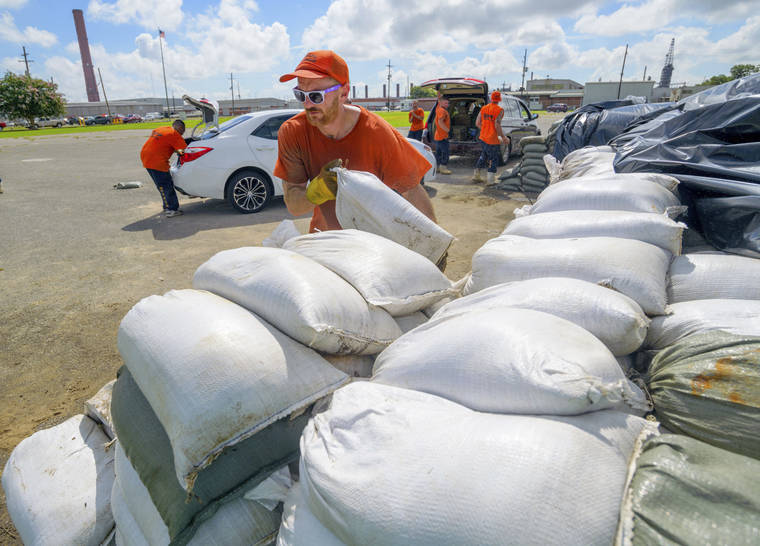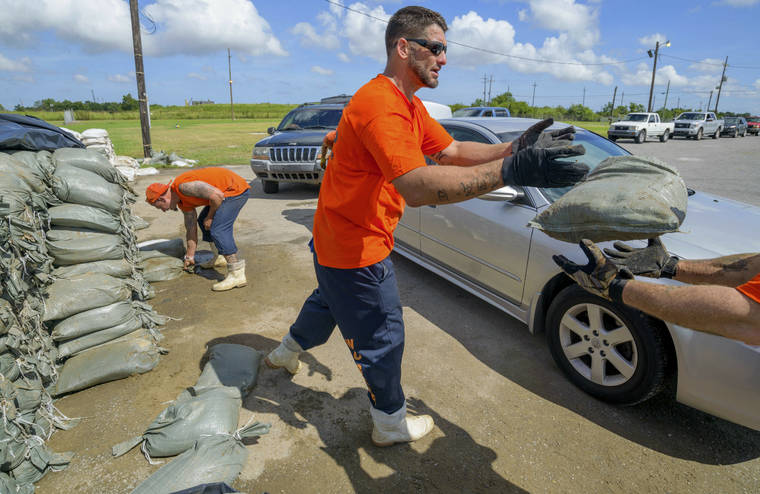NEW ORLEANS — Tropical Storm Barry formed off the coast of Louisiana on Thursday and threatened to blow ashore as a hurricane with relatively weak winds but torrential rains that could test the flood-control improvements made in New Orleans since Hurricane Katrina 14 years ago.
Forecasters said the first hurricane of the Atlantic season could hit the state’s swampy southern tip Friday night or early Saturday, with potentially ruinous downpours that could go on for hours as the storm pushes inland.
Plaquemines Parish, at Louisiana’s southeastern tip, ordered the mandatory evacuation of as many as 10,000 people, and communities began handing out sandbags. Louisiana Gov. John Bel Edwards declared an emergency and said National Guard troops and high-water vehicles will be positioned all over the state.
“The entire coast of Louisiana is at play in this storm,” he warned.
On Wednesday, with the gathering storm still out over the Gulf of Mexico, it dumped as much as 8 inches (20 centimeters) on metro New Orleans in just three hours. The deluge triggered flash flooding and raised fears about the even heavier rains on the way.
The National Hurricane Center said as much as 20 inches (50 centimeters) of rain could fall in parts of eastern Louisiana, including Baton Rouge, and the entire region could get as much as 10 inches (25 centimeters). New Orleans could receive 10 inches, forecasters aid.
The storm’s surge also could prevent water from emptying out of the already-swollen Mississippi River, possibly sending water over levees near New Orleans, forecasters said. The river has been running high for months.
The National Hurricane Center said Barry could have maximum sustained winds of about 75 mph (120 kph), just over the 74 mph threshold for a hurricane, when it comes ashore, making it a Category 1 storm.
In New Orleans, where Katrina in 2005 caused catastrophic flooding that was blamed altogether for more than 1,500 deaths in Louisiana and other states, officials asked people to keep at least three days of supplies on hand and to keep their neighborhood storm drains clear so water can move quickly.
After Katrina, the Army Corps of Engineers began a multibillion-dollar hurricane-protection system that isn’t yet complete. The work included repairs and improvements to some 350 miles of levees and more than 70 pump stations that are used to remove floodwaters.
A spokesman for the Corps in New Orleans said the agency is not expecting widespread overtopping of the levees, but there are concerns for areas south of the city, like Plaquemines Parish.
The parish made sandbags available to people in areas not under evacuations orders, as did several other communities in Louisiana and Mississippi.
The National Weather Service said it expects the river to rise to 19 feet (5.8 meters) by Saturday morning at a key gauge in the New Orleans area, which is protected by levees 20 to 25 feet (6 to 7.6 meters) high.
“We’re confident the levees themselves are in good shape. The big focus is height,” Corps spokesman Ricky Boyett said.
New Orleans got an early taste Wednesday of what may be in store. Floodwaters invaded downtown hotels and businesses and turned streets into rivers, paralyzing rush-hour traffic and stalling cars. Some people paddled their way around in kayaks.
It all happened fast.
“I must have got to work about a quarter to 7,” said Donald Smith, who saw his restaurant on Basin Street flood for the third time this year. “By 7:15, water was everywhere.”
The city’s Sewerage and Water Board said the pumping system that drains the streets was at full capacity. But the immense amount of rain in three hours would overwhelm any system, said agency director Ghassan Korban.
As the water from Wednesday morning’s storms receded, people worried about what might come next.
Tanya Gulliver-Garcia was trying to make her way home during the deluge. Flooded streets turned a 15-minute drive into an ordeal lasting more than two hours.
“This is going to be a slow storm,” she said. “That’s what I’m concerned about.”
Tourists Floyd and Missy Martin of Raleigh, North Carolina, were trying to make the best of it at a store with puddles on the floor where they were buying an umbrella, chips and peanuts, and two bottles of red wine.
“We could drown out our sorrows or make an adventure of it,” Floyd Martin joked.
———
Associated Press reporters Chevel Johnson and Janet McConnaughey contributed to this report from New Orleans.




